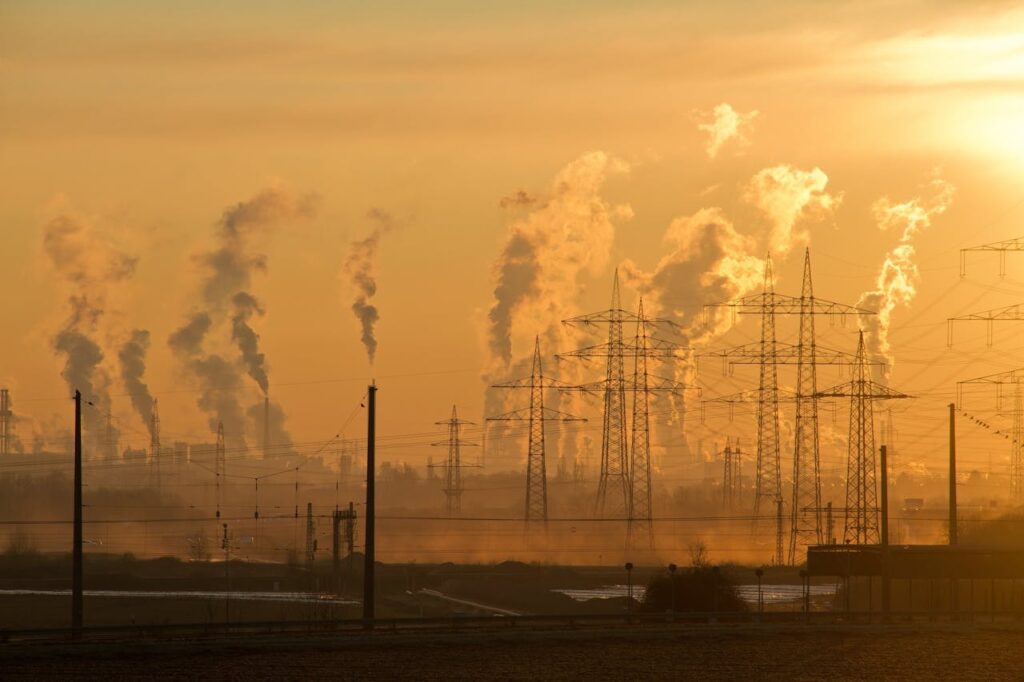1. Clean Air = A Healthier You

The air we breathe is often taken for granted, but it plays a major role in our overall health. Clean air provides the oxygen your body needs to fuel every cell, support brain function, and regulate essential processes. When the Earth’s air is polluted with chemicals, vehicle emissions, and factory fumes, it harms the very air we need to thrive. Studies have shown that long-term exposure to air pollution can lead to chronic conditions like asthma, heart disease, lung cancer, and even cognitive decline. According to MedicalNewsToday, people living in areas with high pollution levels often experience a reduction in life expectancy due to the constant strain on their respiratory and cardiovascular systems.
On the flip side, natural ecosystems like forests, wetlands, and oceans are vital air purifiers. Trees and plants absorb carbon dioxide and release oxygen, while wetlands help filter pollutants. When we destroy forests, increase industrial activity, and neglect clean air initiatives, we not only harm the planet but directly contribute to worsening public health. Protecting the Earth’s ecosystems—by planting trees, reducing emissions, and supporting sustainable practices—improves the quality of the air, which, in turn, supports longer, healthier lives for all of us.
2. Healthy Soil Equals Nutritious Food

Soil health directly impacts the quality and nutritional content of the food we eat. Healthy soil, rich in organic matter and minerals, supports plant life and ensures that crops are full of essential vitamins and nutrients. When the earth’s soil is overworked, eroded, or depleted of its nutrients, the food produced lacks vital components like magnesium, calcium, and iron. According to Frontiers, soils abundant in organic matter foster healthier crops that are more nutrient-dense.This results in a decrease in the overall nutritional density of our diet, leaving us vulnerable to deficiencies and related health issues, such as weakened immunity and poor bone health.
The alarming decline in soil health is directly linked to modern agricultural practices that rely heavily on chemical pesticides, synthetic fertilizers, and monocropping. These practices degrade soil over time, stripping it of the nutrients needed to nourish healthy crops. By practicing sustainable farming techniques, such as crop rotation, composting, and avoiding harmful chemicals, we can restore soil health and ensure that the food we eat is nutrient-rich. Protecting and enriching the Earth’s soil not only ensures better nutrition but also supports healthier, more resilient human populations.
3. Water Quality Affects Your Health

Water is essential for human life, making up a large portion of our bodies. Hydration affects every process in the body, from digestion to cognitive function. However, when Earth’s water sources—such as rivers, lakes, and oceans—become contaminated with pollutants, heavy metals, and plastics, this affects the quality of the water we consume. Polluted water can introduce harmful toxins into our bodies, leading to diseases like cholera, kidney problems, and cancer. According to MedicalNewsToday, the more polluted the water, the greater the risk for serious health conditions, and in some cases, the resources for safe drinking water may be limited altogether.
Conversely, the Earth’s natural water systems, including rainwater and pristine freshwater sources, offer us the clean, mineral-rich water that we need for optimal health. By protecting these water sources—through better waste management, reducing plastic use, and preventing industrial contamination—we ensure that our bodies receive the pure, life-sustaining hydration they need. Conserving and restoring natural water resources is not just about protecting the planet; it’s about safeguarding the health of every individual who depends on this precious resource for survival.
4. Climate Change Increases Health Risks

Climate change is not only an environmental issue—it’s a direct health issue. Rising global temperatures are causing more frequent and severe heatwaves, which increase the risk of heatstroke, dehydration, and heat-related deaths, according to the Environmental Protection Agency (EPA). As temperatures climb, vector-borne diseases, such as malaria, dengue, and Zika, are spreading to new regions where they were previously not common, putting millions of people at risk. The increase in extreme weather events—such as hurricanes, floods, and wildfires—also poses risks to human health by disrupting access to clean water, food supplies, and medical care.
Furthermore, climate change can exacerbate pre-existing health conditions, such as respiratory problems caused by increased air pollution. The increased frequency of natural disasters often leads to stress, displacement, and mental health issues. Combatting climate change through reducing carbon emissions, transitioning to renewable energy, and preserving natural ecosystems will not only protect the planet but also help prevent the spread of disease, reduce physical and mental health risks, and improve overall public health outcomes.
5. Biodiversity Boosts Immunity and Mental Well-Being

Biodiversity refers to the variety of life forms on Earth, from plants and animals to microorganisms. A diverse ecosystem supports human health in several critical ways. For example, healthy ecosystems offer an abundance of medicinal plants and herbs that have been used for centuries in traditional medicine, according to the Co-operation on Health and Biodiversity
. Furthermore, the presence of diverse wildlife helps maintain balance in the ecosystem, regulating everything from insect populations to plant growth. When biodiversity is threatened by deforestation, pollution, or habitat loss, it weakens the Earth’s ability to support life—and human health suffers as a result.Research has shown that time spent in nature, particularly in biodiverse environments like forests or wetlands, can significantly improve mental health. Spending time among a wide variety of plants and animals reduces stress, anxiety, and depression. Nature’s diversity also promotes greater immunity, as exposure to different environmental factors helps the body build resilience. By conserving biodiversity, we strengthen the Earth’s ability to heal and provide people with the tools they need to stay mentally and physically healthy.
6. The Air-Soil-Water-Health Cycle

The Earth’s health and our own are interconnected through a powerful cycle involving air, soil, water, and human well-being. Clean air nourishes the soil, which in turn produces healthy plants. Healthy plants absorb water from clean rivers and lakes, which provides nourishment to our bodies. When any part of this cycle is disrupted—such as soil degradation, air pollution, or water contamination—the entire system is affected. This interconnectedness shows that protecting one aspect of the Earth directly improves multiple facets of our health. For example, restoring forests not only improves air quality by absorbing carbon dioxide but also helps preserve soil health, boosts water retention, and prevents flooding—all of which contribute to human health.
Unfortunately, this cycle is increasingly under threat due to unsustainable agricultural practices, pollution, and habitat destruction. For instance, deforestation contributes to soil erosion, making it harder for plants to grow while also disrupting the water cycle. The more we damage one part of the cycle, the more we harm ourselves. However, by adopting sustainable practices, such as reforestation, organic farming, and clean energy, we can restore the balance between the Earth’s systems and ensure that future generations continue to benefit from the resources they provide.
7. Ecotherapy and Your Mental Health

Nature-based therapies, such as ecotherapy, are gaining recognition for their profound benefits to mental health. These practices involve engaging with nature—whether it’s gardening, hiking, or simply walking in a park—to boost mood, reduce anxiety, and improve overall well-being. Being surrounded by natural beauty can significantly reduce cortisol levels (stress hormones) and promote a sense of calm and mindfulness. Research shows that spending time in green spaces increases serotonin production, which helps combat depression and anxiety.
In contrast, urban living, with its concrete jungles, constant noise, and limited green spaces, can lead to mental fatigue, depression, and increased stress. Nature provides not only aesthetic beauty but a sanctuary for healing and restoration. By protecting natural spaces and ensuring access to them, we are investing in better mental health and helping communities thrive. Access to nature isn’t just about enjoying the outdoors—it’s about protecting human well-being at a fundamental level.
8. Natural Disasters and Human Vulnerability

The increase in natural disasters, linked to climate change, highlights the vulnerabilities between human health and the Earth’s stability. Wildfires, floods, hurricanes, and earthquakes can devastate communities, leading to loss of life, displacement, and destruction of infrastructure. The aftermath often results in health emergencies, including the spread of infectious diseases, lack of access to clean water, and mental health crises. Communities in disaster-prone areas face constant threats, which can lead to long-term health problems, both physical and psychological.
The link between natural disasters and public health is clear: the more we disrupt the planet’s natural systems, the more we increase our exposure to these events. By mitigating climate change, protecting forests, and investing in disaster resilience, we can reduce the frequency and severity of these disasters. Doing so will not only protect the planet but also reduce the public health burden caused by extreme events, ensuring a safer and healthier environment for future generations.
9. Urbanization and Health Inequality

As urbanization accelerates around the world, health inequalities are becoming more pronounced. While cities offer access to healthcare and education, they also expose residents to pollution, overcrowding, limited green spaces, and higher rates of chronic diseases like asthma, heart disease, and diabetes. These challenges disproportionately affect low-income communities, who often live in the most polluted and underresourced areas. Furthermore, urban living can contribute to mental health issues like depression, social isolation, and anxiety, particularly for those without access to nature.
On the other hand, rural communities—while often facing different challenges—tend to benefit from cleaner air, natural spaces, and a slower pace of life. Green urban planning and the incorporation of natural elements into city design, such as green roofs and community gardens, can help reduce health inequalities. Cities that prioritize sustainable, eco-friendly infrastructure not only benefit the planet but also improve the health outcomes of their residents, creating a more equitable society for everyone.
10. The Connection Between Forests and Disease Prevention

Forests are more than just beautiful landscapes—they are health powerhouses. These vital ecosystems play an essential role in disease prevention by absorbing harmful carbon dioxide and pollutants while releasing fresh oxygen. Tree-rich areas are also shown to reduce stress, promote physical activity, and improve overall mental well-being. Furthermore, forests act as buffers against disease spread by regulating ecosystems and preventing the overgrowth of disease-carrying pests.
In regions where forests are being destroyed at alarming rates, the loss goes beyond environmental impact—it can exacerbate health problems. Without forests to clean the air and provide natural resources, nearby populations experience increased rates of respiratory diseases, cardiovascular problems, and even infectious diseases. By protecting forests, we not only preserve biodiversity and natural beauty, but we also ensure that communities are less vulnerable to disease and maintain access to critical natural health resources.
11. The Loss of Green Spaces and Rising Mental Health Issues

In today’s fast-paced world, green spaces are often sacrificed for urban development, leading to an increase in stress, anxiety, and mental health disorders. Research has shown that exposure to nature significantly reduces cortisol levels (the stress hormone), lowers blood pressure, and enhances overall mental well-being. Yet, as cities expand, forests are cleared, and parks are neglected, fewer people have access to the therapeutic benefits of greenery. This has resulted in higher rates of depression, anxiety disorders, and even increased aggression in urban environments.
Moreover, the loss of green spaces reduces opportunities for physical activity, such as walking, jogging, or even simply sitting in nature to unwind. Children growing up in nature-deprived areas miss out on essential cognitive and emotional benefits, often displaying higher levels of hyperactivity, mood disorders, and reduced focus. Protecting and restoring green spaces in both cities and rural areas is not just an environmental necessity—it’s a mental health strategy that directly influences the quality of life for millions.
12. Ocean Health Affects Human Nutrition and Livelihoods

The health of the world’s oceans is directly tied to human survival, particularly for communities that depend on fishing for food and economic stability. Overfishing, pollution, rising sea temperatures, and coral reef destruction are depleting marine life at alarming rates, leading to food shortages and nutritional deficiencies for millions of people. Seafood provides essential omega-3 fatty acids, iodine, and protein, but as fish populations decline, so does access to nutrient-rich food sources.
Beyond nutrition, the destruction of marine ecosystems threatens entire coastal communities, many of which rely on fishing for their livelihoods. Climate change is also causing rising sea levels, leading to displacement, loss of homes, and increased exposure to extreme weather conditions like hurricanes and typhoons. When we protect the oceans—through sustainable fishing, reducing plastic pollution, and mitigating climate change—we ensure not only the survival of marine life but also the economic stability and health of people who depend on it.
13. Extreme Heat and the Dangers of Heat-Related Illnesses

As global temperatures rise due to climate change, extreme heat is becoming a deadly health threat in many parts of the world. Heatwaves are causing dehydration, heatstroke, cardiovascular complications, and even death, especially among vulnerable populations like the elderly, children, and outdoor workers. Cities, which are often covered in heat-absorbing materials like concrete and asphalt, experience even more intense heat due to the urban heat island effect, making them far hotter than surrounding rural areas.
Aside from immediate heat-related illnesses, prolonged exposure to high temperatures weakens the body’s ability to regulate itself, leading to chronic kidney disease, neurological disorders, and weakened immunity. The best way to combat extreme heat is by reducing greenhouse gas emissions, increasing urban greenery, and implementing cooling infrastructure like reflective roofs and water-based cooling systems. Our response to climate change will determine whether extreme heat becomes a manageable challenge or a mass health crisis in the years to come.


